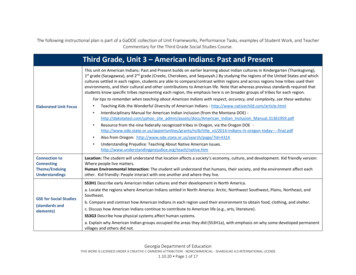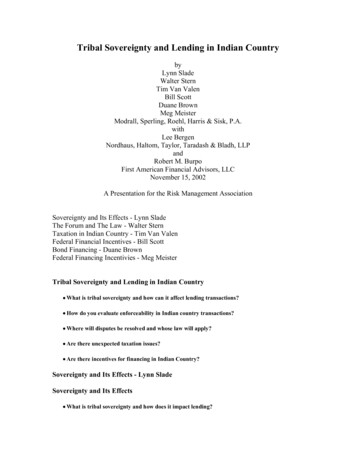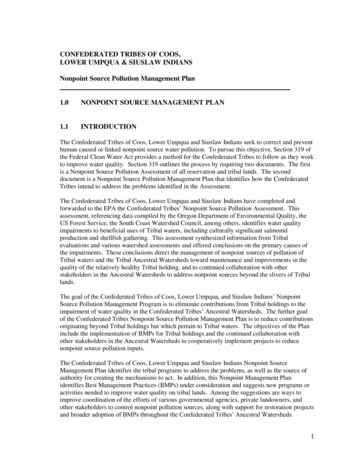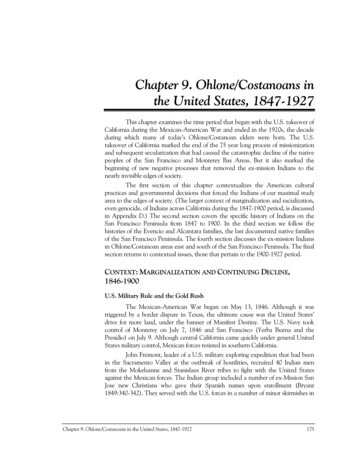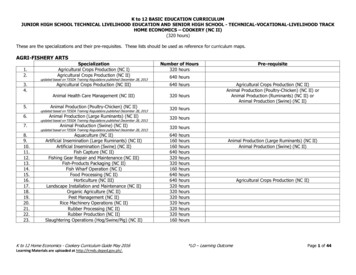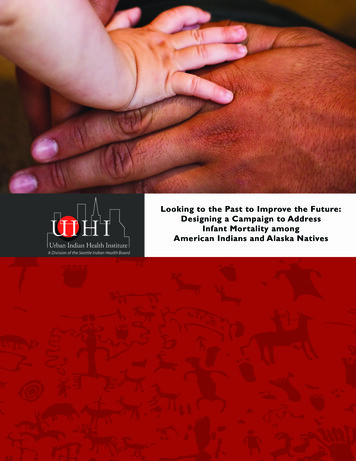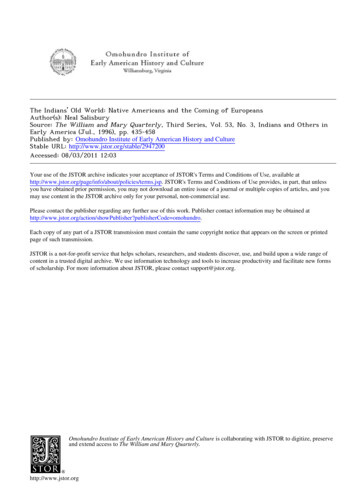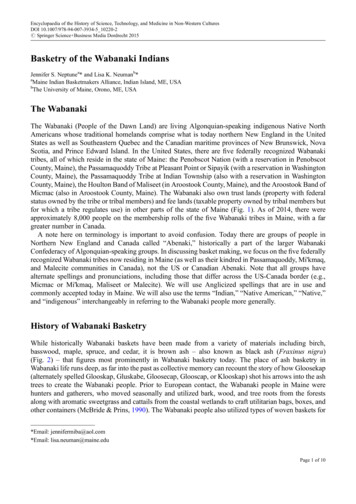
Transcription
Encyclopaedia of the History of Science, Technology, and Medicine in Non-Western CulturesDOI 10.1007/978-94-007-3934-5 10220-2# Springer Science Business Media Dordrecht 2015Basketry of the Wabanaki IndiansJennifer S. Neptunea* and Lisa K. Neumanb*aMaine Indian Basketmakers Alliance, Indian Island, ME, USAbThe University of Maine, Orono, ME, USAThe WabanakiThe Wabanaki (People of the Dawn Land) are living Algonquian-speaking indigenous Native NorthAmericans whose traditional homelands comprise what is today northern New England in the UnitedStates as well as Southeastern Quebec and the Canadian maritime provinces of New Brunswick, NovaScotia, and Prince Edward Island. In the United States, there are five federally recognized Wabanakitribes, all of which reside in the state of Maine: the Penobscot Nation (with a reservation in PenobscotCounty, Maine), the Passamaquoddy Tribe at Pleasant Point or Sipayik (with a reservation in WashingtonCounty, Maine), the Passamaquoddy Tribe at Indian Township (also with a reservation in WashingtonCounty, Maine), the Houlton Band of Maliseet (in Aroostook County, Maine), and the Aroostook Band ofMicmac (also in Aroostook County, Maine). The Wabanaki also own trust lands (property with federalstatus owned by the tribe or tribal members) and fee lands (taxable property owned by tribal members butfor which a tribe regulates use) in other parts of the state of Maine (Fig. 1). As of 2014, there wereapproximately 8,000 people on the membership rolls of the five Wabanaki tribes in Maine, with a fargreater number in Canada.A note here on terminology is important to avoid confusion. Today there are groups of people inNorthern New England and Canada called “Abenaki,” historically a part of the larger WabanakiConfederacy of Algonquian-speaking groups. In discussing basket making, we focus on the five federallyrecognized Wabanaki tribes now residing in Maine (as well as their kindred in Passamaquoddy, Mi'kmaq,and Malecite communities in Canada), not the US or Canadian Abenaki. Note that all groups havealternate spellings and pronunciations, including those that differ across the US-Canada border (e.g.,Micmac or Mi'kmaq, Maliseet or Malecite). We will use Anglicized spellings that are in use andcommonly accepted today in Maine. We will also use the terms “Indian,” “Native American,” “Native,”and “indigenous” interchangeably in referring to the Wabanaki people more generally.History of Wabanaki BasketryWhile historically Wabanaki baskets have been made from a variety of materials including birch,basswood, maple, spruce, and cedar, it is brown ash – also known as black ash (Fraxinus nigra)(Fig. 2) – that figures most prominently in Wabanaki basketry today. The place of ash basketry inWabanaki life runs deep, as far into the past as collective memory can recount the story of how Gloosekap(alternately spelled Glooskap, Gluskabe, Gloosecap, Glooscap, or Klooskap) shot his arrows into the ashtrees to create the Wabanaki people. Prior to European contact, the Wabanaki people in Maine werehunters and gatherers, who moved seasonally and utilized bark, wood, and tree roots from the forestsalong with aromatic sweetgrass and cattails from the coastal wetlands to craft utilitarian bags, boxes, andother containers (McBride & Prins, 1990). The Wabanaki people also utilized types of woven baskets for*Email: jennifermiba@aol.com*Email: lisa.neuman@maine.eduPage 1 of 10
Encyclopaedia of the History of Science, Technology, and Medicine in Non-Western CulturesDOI 10.1007/978-94-007-3934-5 10220-2# Springer Science Business Media Dordrecht 2015Fig. 1 Map of Wabanaki territory. Showing tribal reservations, trust, and fee lands in Maine (Courtesy of James Eric Francis, Sr.)washing corn, sifting, and carrying supplies. Some evidence suggests that the arrival of Europeans andtheir roles as trading partners may have accelerated Wabanaki production of splint basketry – that is,baskets produced using thin uniform strips of wood braided or woven together – from forest resources likeash, cedar, spruce, and maple (McBride & Prins, 1990). It is clear that splint basketry – especially thatconstructed from the versatile brown ash – is central to Wabanaki cultural and spiritual life.Historically a skill passed down within families, basket making took on new economic, cultural, andsocial meanings for Wabanaki communities beginning in the eighteenth century, as traders, tourists,Page 2 of 10
Encyclopaedia of the History of Science, Technology, and Medicine in Non-Western CulturesDOI 10.1007/978-94-007-3934-5 10220-2# Springer Science Business Media Dordrecht 2015Fig. 2 Black ash trees. They can grow 60–70 f. in height and reach a trunk diameter of 8–24 in., producing a small cluster ofbranches high off the ground (Courtesy of Jennifer Neptune)Fig. 3 Penobscot women and girl weaving outdoors on Indian Island, Maine, early twentieth century (Courtesy of HudsonMuseum, the University of Maine)museums, and basket makers helped shape a consumer market for Wabanaki baskets (Bourque & Labar,2009). As non-Native vendors and collectors sought out Wabanaki baskets as consumer goods of artisticvalue, indigenous basket makers traveled to major cities like Boston, New York, and Philadelphia alongthe Eastern seaboard to sell their products (Neptune, 2008a). Beginning in the mid-nineteenth century,Wabanaki families set up encampments in well-known resort towns such as Kennebunkport and BarHarbor on Mt. Desert Island, Maine, to sell their baskets and other crafts to wealthy summer residents andvacationers (McBride & Prins, 2009). New styles of ornamentation and decorative weaves accompaniedPage 3 of 10
Encyclopaedia of the History of Science, Technology, and Medicine in Non-Western CulturesDOI 10.1007/978-94-007-3934-5 10220-2# Springer Science Business Media Dordrecht 2015Fig. 4 Penobscot women and boy making baskets in their living room, early twentieth century (Courtesy of Hudson Museum,the University of Maine)the introduction in the 1860s of labor-saving commercial aniline dyes, which allowed for a brighter andmore varied basket color pallet (Neptune, 2008b; Whitehead, 2004). By the mid-1880s, new technologiesimproved the manufacturing of tools like wood splitters, gauges, and blocks for holding a basket’s shape,which helped Wabanaki basket makers create even smaller and fancier decorative baskets (Mundell,2008). For example, Penobscot men who worked at canoe factories in Old Town, Maine, used factorylathes to create new shapes and styles of basket blocks. By the turn of the twentieth century, tribal censusdata reveal that almost every Passamaquoddy and Penobscot household had at least one member whoseprimary occupation was basket maker. Making baskets was a communal and intergenerational activity(Figs. 3 and 4). Women would often host sweetgrass braiding parties in their homes, and children couldobserve the work of adults and sometimes make their own miniature baskets.During the twentieth century, several historical events profoundly affected Wabanaki basket makers.A decline in tourism due to the Great Depression and the onset of World War II (in which many Wabanakimen and women served) and postwar Wabanaki migration to southern New England (spurred by new jobopportunities and the desire to escape racial prejudice back home) led to a decline in the number ofWabanaki basket makers during the middle part of the twentieth century. From the 1950s to the 1980s,competition from foreign imports and the development of plastic containers, coupled with changes in thepotato and fishing industries that led to less demand for Wabanaki utility baskets, promoted further declinein the number of basket makers. Moreover, during this time period, coastal development and changes inland use restricted Wabanaki access to traditional ash and sweetgrass gathering and selling sites. Thenorthern extension of the interstate highway system I-95 during the 1960s diverted traffic away from thePenobscot reservation in Old Town, Maine, taking with it potential customers for basket makers. By the1990s, it is estimated that there were fewer than one dozen Wabanaki basket makers left under the age of40 (Neptune, 2008b).In 1993, Wabanaki basket makers created the nonprofit Maine Indian Basketmakers Alliance (MIBA)to help market their baskets, educate the public about tribal issues, revitalize aspects of traditionalWabanaki languages and cultures, and pass on basket-making skills to younger generations throughapprenticeships with elder basket makers. Wabanaki basket makers have written a number of books aboutWabanaki basketry, including the styles of Penobscot, Passamaquoddy, Micmac, and Maliseet basketmakers (see Sanipass, 1990; Soctomah, 2003; Nichols, Francis, Francis, & Soctomah, 2008). Basketmakers display and sell their baskets at a number of venues, including the Abbe Museum in Bar Harbor,Page 4 of 10
Encyclopaedia of the History of Science, Technology, and Medicine in Non-Western CulturesDOI 10.1007/978-94-007-3934-5 10220-2# Springer Science Business Media Dordrecht 2015Fig. 5 Emerald Ash Borer emerging from an ash tree (Photo by Jennifer Neptune. Courtesy of Maine Indian BasketmakersAlliance)Fig. 6 Splitting black ash splints with a wooden tool known as a splitter (Photo by Jennifer Neptune)Maine, as well as seasonal basket shows at locations around the state of Maine, which also provideopportunities for extended families and friends to socialize (Neuman, 2010). Wabanaki basket makersalso have a presence in larger international Native American arts markets, such as Santa Fe Indian Market,with weavers receiving first place and best of show ribbons. Today, museum-quality Wabanaki basketsmade by well-known basket makers can fetch as much as a few thousand dollars apiece – a far cry from thepocket change that early twentieth-century tourists would often pay for baskets. For most weavers, basketmaking provides a modest income and may supplement other forms of employment. Moreover, for manyWabanaki people, basket making signifies a process of decolonization, as the production of baskets isinseparable from assertions of tribal/band sovereignty, land use rights, and indigenous identities intwenty-first-century America and Canada (Sockbeson, 2009). However, Wabanaki basket makers facenew twenty-first-century threats, including co-option of their intellectual property rights byPage 5 of 10
Encyclopaedia of the History of Science, Technology, and Medicine in Non-Western CulturesDOI 10.1007/978-94-007-3934-5 10220-2# Springer Science Business Media Dordrecht 2015Fig. 7 Gauge for cutting splints (Photo by Jennifer Neptune)Fig. 8 Picking sweetgrass for weaving (Photo by Jennifer Neptune)non-Wabanaki people, restrictions on access to their traditional brown ash and sweetgrass harvestingsites, and an invasive species of ash-destroying beetle: the Emerald Ash Borer (Agrilus planipennis)(Fig. 5).Procuring and Preparing MaterialsBrown ash possesses unique characteristics that make it an ideal material for making baskets. Brown ashis strong enough that it can be woven into sturdy utility baskets, yet it is flexible enough to be woven intohighly detailed, intricate, and delicate ornamental baskets, known as “fancy” baskets. Its growth rings canbe pounded and split into fine splints that are ideal for weaving. However, not all brown ash trees – whichtend to grow in wet areas – make good basket trees. Basket makers who harvest brown ash carefully selectPage 6 of 10
Encyclopaedia of the History of Science, Technology, and Medicine in Non-Western CulturesDOI 10.1007/978-94-007-3934-5 10220-2# Springer Science Business Media Dordrecht 2015Fig. 9 Utility baskets by Peter Neptune (Passamaquoddy) (Courtesy of Maine Indian Basketmakers Alliance)Fig. 10 Fancy baskets by Passamaquoddy weavers Clara Keezer and Theresa Gardner (Photo by Jennifer Neptune)individual trees based on a set of complex technical criteria for matching individual trees to their basketmaking needs. For example, by notching a small section of the trunk with an axe, a harvester can tellyearly tree ring growth and its suitability for a utility or fancy basket.Once an ideal basket tree has been identified, it is cut into lengths of 4–12 ft. A spiritual offering may begiven at the time a tree is cut. After removing the bark, harvesters use the blunt side of an axe to pounddown the length of the log, which separates and releases the growth rings into layers. This produces longstraight splints of 4–12 ft in length. As the ash is being pounded, the splints may be split into thinnersegments using a splitter (Fig. 6).Once a growth ring is divided into two parts, it may be split into even finer segments that can be paperthin in some cases. Splitting the ash creates new thinner segments that contain the original rough sides andnew smooth surfaces. The rough sides may be smoothed with a knife in a process called scraping. Thesmooth thinner segments are ideal for delicate fancy baskets. At that point, the splints can be coiled andstored for later or they can be pulled through a sharp-toothed instrument called a gauge (Fig. 7), which cutsthem into the desired widths.Along with brown ash splints, basket makers harvest a highly aromatic marsh-loving grass calledsweetgrass, which is integrated into the weave. In addition to being highly prized as a weaving material,Page 7 of 10
Encyclopaedia of the History of Science, Technology, and Medicine in Non-Western CulturesDOI 10.1007/978-94-007-3934-5 10220-2# Springer Science Business Media Dordrecht 2015sweetgrass plays an important role in spiritual and cultural practices (Fig. 8). Sweetgrass became moreprominent in fancy baskets during the mid-nineteenth century, as Wabanaki traditional summer villagesites on the Maine coast began to overlap with the growth of summer resorts and a new tourist market forbaskets.Weaving BasketsNow the weaving process begins. Wide splints (called standards) are woven to form the base of the basket,and smaller splints that have been gauged into narrower widths (called weavers) are woven to form thesides and the bottom of the basket. Many basket makers use a wooden form called a block, which is tied tothe base to help shape the sides as they are being constructed. After the sides have been woven, the blockis then removed. The rim of the basket is then bound by tucking in the standards and finishing the rim’sedge with materials, like sweetgrass, that strengthen it and add a decorative touch. Basket makers mayweave covers or carve handles for their baskets.There are two major categories of Wabanaki baskets: utility baskets and fancy baskets. Heavier andsturdier utility baskets are generally used for gathering, transporting, processing, and storing food andother items. Two of the most recognizable styles of utility basket are the pack basket (often used in canoes)and the potato basket, which was essential for agriculture in Maine. Function, and not ornamentation,governs the production of utility baskets (Fig. 9).On the other hand, fancy baskets are defined by and sought after for their ornamentation. Weavers willmanipulate the ash into curls, twists, and points. Brightly colored and sometimes whimsical fancy basketsin the shapes of foods like blueberries, strawberries, pumpkins, pinecones, and corn are a hallmark of theWabanaki style of basketry (Fig. 10).Economic, Environmental, Social, and Cultural Dimensions of WabanakiBasketry TodayThe Maine Indian Basketmakers Alliance has succeeded in bringing together the technical knowledge andspecialized skills of various basket makers into one organization dedicated to the preservation of the craft.The MIBA’s program of pairing master basket makers with apprentices, with the explicit goal ofpreserving traditional knowledge (including Wabanaki language) and increasing the number of youngerbasket weavers, has been extremely successful. Today, there are approximately 200 Wabanaki basketmakers in Maine. The MIBA has also been successful in marketing Wabanaki basketry and promoting itsstatus as an art form among collectors; this also has helped raise consumer demand and prices for baskets.Yet, Wabanaki basket makers in the twenty-first century face several threats. Access to traditional ashand sweetgrass gathering spots has been diminished due to coastal development, changing landownerattitudes concerning access, and new regulations imposed by large-scale landowners such as papercompanies. Basket makers also must contend with infringement on their intellectual property rights:some businesses and individuals copy their unique styles and attempt to sell baskets as “Wabanaki” thatare not made by Penobscot, Passamaquoddy, Micmac, or Maliseet artisans. It is no wonder that manybasket makers link their practice of making baskets to cultural survival and decolonization – that is, theircontinuing struggle against the effects of encroachment on their lands and traditions by outsiders.However, perhaps the most pressing issue for Wabanaki basket makers today is the environmentalthreat posed by an invasive insect known as the Emerald Ash Borer. Discovered in 2002 in Michigan, theEmerald Ash Borer is believed to have traveled to North America on shipping pallets from Asia. ThisPage 8 of 10
Encyclopaedia of the History of Science, Technology, and Medicine in Non-Western CulturesDOI 10.1007/978-94-007-3934-5 10220-2# Springer Science Business Media Dordrecht 2015small beetle kills all species of ash trees and has destroyed millions of trees since its arrival. Adult beetleslay their eggs on the bark of the tree, and the hatching larvae bore into the tree to feed on the inner bark.As the larvae feed, they create “S”-shaped galleries, which eventually girdle the tree, effectively killingthe tree from the inside out. Infestations can be hard to detect, as symptoms often are not visible for threeor more years. The Emerald Ash Borer has rapidly spread from the Great Lakes region of the United Statesto other areas, moving into the central, southern, and eastern United States as well as the Canadianprovinces of Ontario and Quebec. Emerald Ash Borer on its own would spread over the landscape fairlyslowly; however, humans have accelerated its spread by transporting infected firewood, logs, and nurserystock hundreds and sometimes thousands of miles. While natural predators help keep the Emerald AshBorer in check in Asia, it has no natural enemies here. Left unchecked, it threatens to destroy virtually allof the ash trees in North America.The Future of Wabanaki BasketryBasket makers have adopted a number of proactive strategies to ensure the future of Wabanaki basketry.Since 2010, Maine has banned the importation and transportation of firewood into Maine from otherstates. Wabanaki basket makers and Wabanaki scholars testified before the Maine Legislature and playeda major role in the enactment of this legislation. Wabanaki basket makers – along with policymakers,forest service employees, and scholars from around the country – have formed black ash task forces toprepare for the arrival of the beetle, held symposia dedicated to preserving and sharing vital informationabout ash trees, and collaborated on cross-country field trips to learn how to identify the Emerald AshBorer, to recognize damage and signs of the beetle, and to share strategies and knowledge about copingwith the damage that will be caused by the beetle. Basket makers and conservationists are also savingseeds to preserve the ash trees for future generations.Cultural knowledge is being preserved as well. Wabanaki ash harvesters are creating filmed records oftree identification, processing, and basket making so that this knowledge can be archived for futuregenerations of Wabanaki basket makers. Some Wabanaki basket makers are also diversifying thematerials they are using to craft baskets, returning to other traditional materials like basswood, birch,maple, and cedar, which are protected from the threat of the Emerald Ash Borer. In 2013, the Maine IndianBasketmakers Alliance, the Penobscot Nation, and the Bangor Museum and History Center pooled theirresources to purchase a rare woven antique Penobscot basswood bag from an estate auction. Now housedat the Hudson Museum at the University of Maine, this basswood bag has the potential to inspire futuregenerations of Wabanaki basket makers.ReferencesBourque, B., & Labar, L. (2009). Uncommon threads: Wabanaki textiles, clothing, and costume. Seattle,WA: University of Washington Press.McBride, B., & Prins, H. (1990). Micmacs and splint basketry: Tradition, adaptation, and survival. InB. McBride (Ed.), Our lives in our hands: Micmac Indian basketmakers (pp. 3–23). Halifax, NS:Nimbus Publishing.McBride, B., & Prins, H. (2009). Indians in Eden: Wabanakis and rusticators on Maine’s Mount DesertIsland, 1840s-1920s. Camden, ME: DownEast Books.Mundell, K. (2008). North by northeast: Wabanaki, Akwesasne Mohawk, and Tuscarora traditional arts.Gardiner, ME: Tilbury House Publishers.Page 9 of 10
Encyclopaedia of the History of Science, Technology, and Medicine in Non-Western CulturesDOI 10.1007/978-94-007-3934-5 10220-2# Springer Science Business Media Dordrecht 2015Neptune, J. (2008a). Wabanaki traditional arts: From old roots to new life. In K. Mundell (Ed.), North bynortheast: Wabanaki, Akwesasne Mohawk, and Tuscarora traditional arts (pp. 25–27). Gardiner, ME:Tilbury House Publishers.Neptune, J. (2008b). Sprit of the basket tree: Wabanaki splint baskets from Maine. Exhibition catalog.Hanover, NH: Dartmouth College, The Hood Museum of Art.Neuman, L. (2010). Basketry as economic enterprise and cultural revitalization: The case of the Wabanakitribes of Maine. Wicazo Sa Review, 25(2), 89–106.Nichols, J. A., Francis, S., Francis, S., & Soctomah, D. (2008). Baskets of the dawnland people. OldTown, ME: Maine Indian Basketmakers Alliance.Sanipass, M. (1990). Basket making step-by-step. Madawaska, ME: St. John Valley Publishing.Sockbeson, R. (2009). Waponahki intellectual tradition of weaving educational policy. Alberta Journal ofEducational Research, 55(3), 351–364.Soctomah, D. (2003). Hard times at Passamaquoddy, 1921–1950: Tribal life and times in Maine and NewBrunswick. Pleasant Point, ME: Donald Soctomah.Whitehead, R. H. (2004). The traditional material culture of the Native peoples of Maine. In B. Bourque(Ed.), Twelve thousand years: American Indians in Maine (pp. 249–309). Lincoln, NE: University ofOregon Press.Page 10 of 10
sweetgrass plays an important role in spiritual and cultural practices (Fig. 8). Sweetgrass became more prominent in fancy baskets during the mid-nineteenth century, as Wabanaki traditional summer village sites onthe Maine coastbegan to overlap with the growth of summer resorts anda newtourist market for baskets. Weaving Baskets



